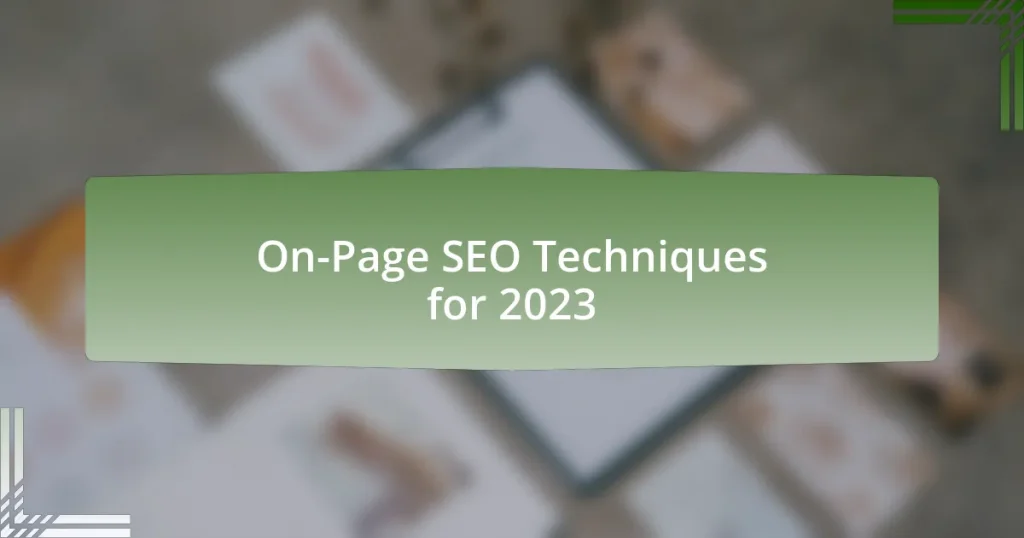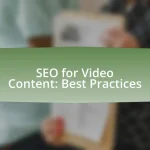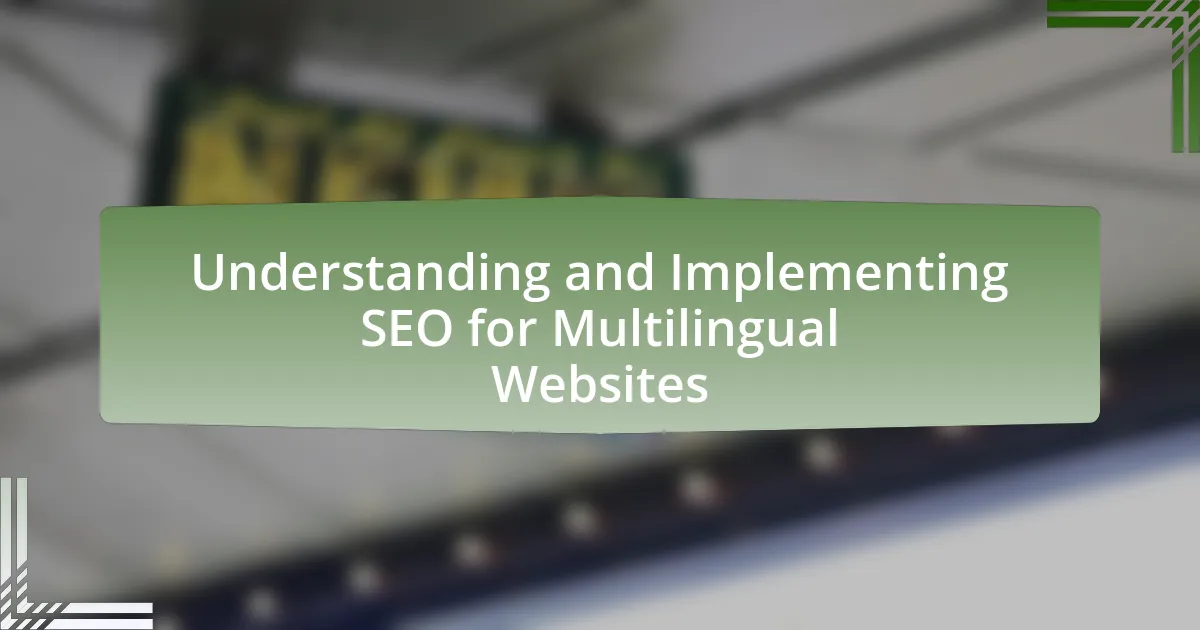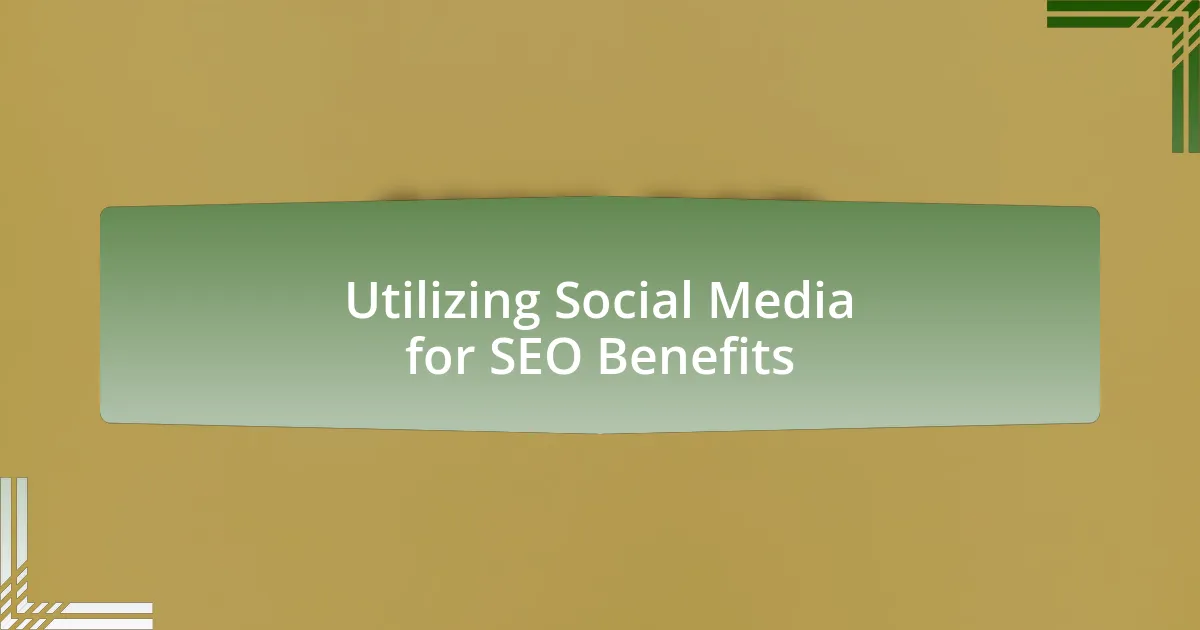On-Page SEO Techniques for 2023 focus on optimizing various elements within a website to enhance its visibility and user experience. Key techniques include optimizing title tags, meta descriptions, header tags, and content for relevant keywords, as well as ensuring mobile-friendliness and improving page load speed. The article distinguishes On-Page SEO from Off-Page SEO, emphasizing the importance of internal optimization for search engine rankings. It also highlights the latest trends, such as user experience and structured data integration, while providing practical tips for effective implementation and common mistakes to avoid. Overall, the article serves as a comprehensive guide to improving website performance through On-Page SEO strategies.
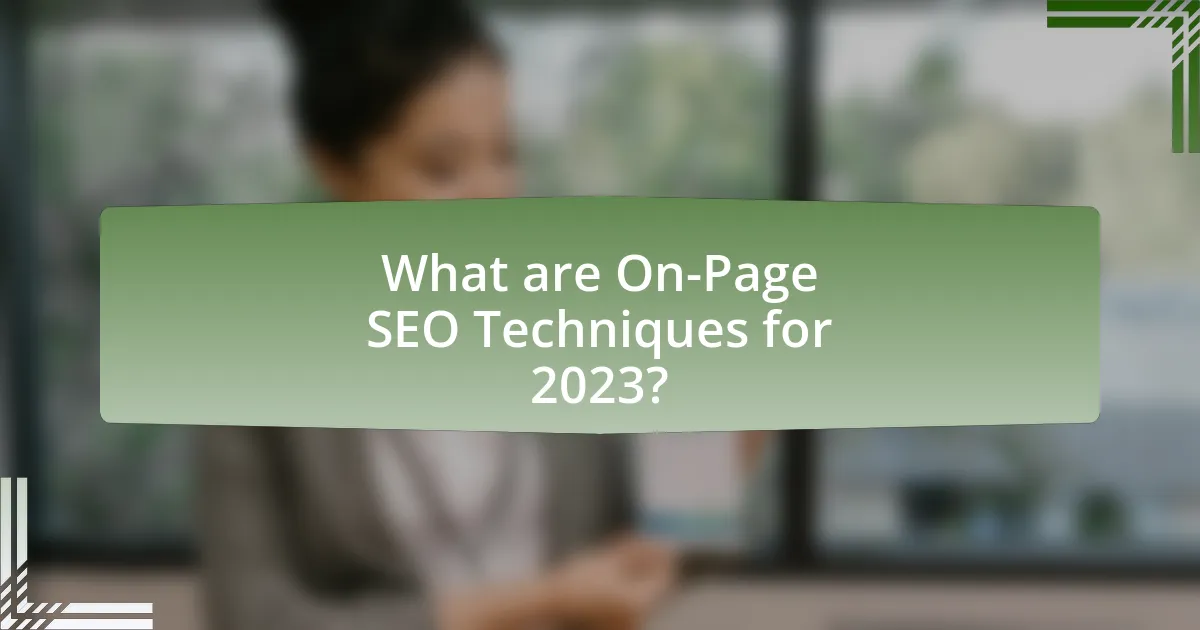
What are On-Page SEO Techniques for 2023?
On-Page SEO techniques for 2023 include optimizing title tags, meta descriptions, header tags, and content for relevant keywords, ensuring mobile-friendliness, improving page load speed, and utilizing structured data. These techniques enhance user experience and search engine visibility. For instance, Google emphasizes the importance of mobile optimization, as over 50% of global web traffic comes from mobile devices. Additionally, according to a study by Backlinko, pages that load within 2 seconds have a significantly lower bounce rate, highlighting the necessity of fast-loading pages for better SEO performance.
How do On-Page SEO Techniques differ from Off-Page SEO?
On-Page SEO techniques focus on optimizing elements within a website to improve its visibility in search engines, while Off-Page SEO techniques involve external factors that influence a site’s ranking. On-Page SEO includes practices such as optimizing title tags, meta descriptions, and content quality, which directly affect how search engines interpret and rank a webpage. In contrast, Off-Page SEO encompasses activities like link building, social media engagement, and brand mentions, which enhance a site’s authority and reputation outside its own pages. The distinction lies in the fact that On-Page SEO is about internal optimization, whereas Off-Page SEO is concerned with external signals that contribute to a site’s overall search engine performance.
What are the key elements of On-Page SEO?
The key elements of On-Page SEO include keyword optimization, meta tags, header tags, content quality, internal linking, and image optimization. Keyword optimization involves strategically placing relevant keywords throughout the content to improve search visibility. Meta tags, such as title tags and meta descriptions, provide concise information about the page’s content and influence click-through rates. Header tags (H1, H2, H3) structure the content, making it easier for search engines to understand the hierarchy and relevance of information. High-quality content that is informative and engaging retains users and reduces bounce rates, which positively impacts rankings. Internal linking connects related content within the website, enhancing navigation and distributing page authority. Image optimization, including alt text and file names, improves accessibility and helps search engines index visual content. These elements collectively enhance a webpage’s relevance and usability, contributing to better search engine rankings.
Why is On-Page SEO important for website ranking?
On-Page SEO is crucial for website ranking because it directly influences how search engines interpret and rank a webpage’s content. Effective On-Page SEO techniques, such as optimizing title tags, meta descriptions, and header tags, enhance the relevance and quality of the content, making it easier for search engines to understand the page’s purpose. According to a study by Backlinko, pages that are optimized for On-Page SEO can rank significantly higher in search results, with the top-ranking pages often having well-structured content and relevant keywords. This correlation demonstrates that On-Page SEO is essential for improving visibility and attracting organic traffic.
What are the latest trends in On-Page SEO for 2023?
The latest trends in On-Page SEO for 2023 include a strong emphasis on user experience, content optimization for search intent, and the integration of structured data. User experience is prioritized as search engines increasingly reward sites that provide fast loading times, mobile responsiveness, and intuitive navigation. Content optimization focuses on aligning with user search intent, ensuring that content answers specific queries effectively. The use of structured data, such as schema markup, enhances visibility in search results by providing search engines with clear context about the content, which can lead to rich snippets and improved click-through rates. These trends reflect the ongoing evolution of SEO practices aimed at enhancing both user satisfaction and search engine performance.
How does user experience influence On-Page SEO?
User experience significantly influences On-Page SEO by affecting key metrics such as bounce rate, dwell time, and user engagement. When a website provides a positive user experience, visitors are more likely to stay longer, interact with content, and return, which signals to search engines that the site is valuable. For instance, Google’s algorithm considers user engagement metrics; a high bounce rate may indicate that users are not finding what they need, leading to lower rankings. Additionally, a well-structured layout, fast loading times, and mobile optimization enhance user experience, further improving SEO performance.
What role does mobile optimization play in On-Page SEO?
Mobile optimization is crucial in On-Page SEO as it directly impacts user experience and search engine rankings. With over 50% of global web traffic coming from mobile devices, search engines like Google prioritize mobile-friendly websites in their algorithms. This prioritization is evident in Google’s mobile-first indexing approach, which means that the mobile version of a site is considered the primary version for ranking purposes. Consequently, websites that are not optimized for mobile may experience lower visibility in search results, leading to decreased organic traffic.
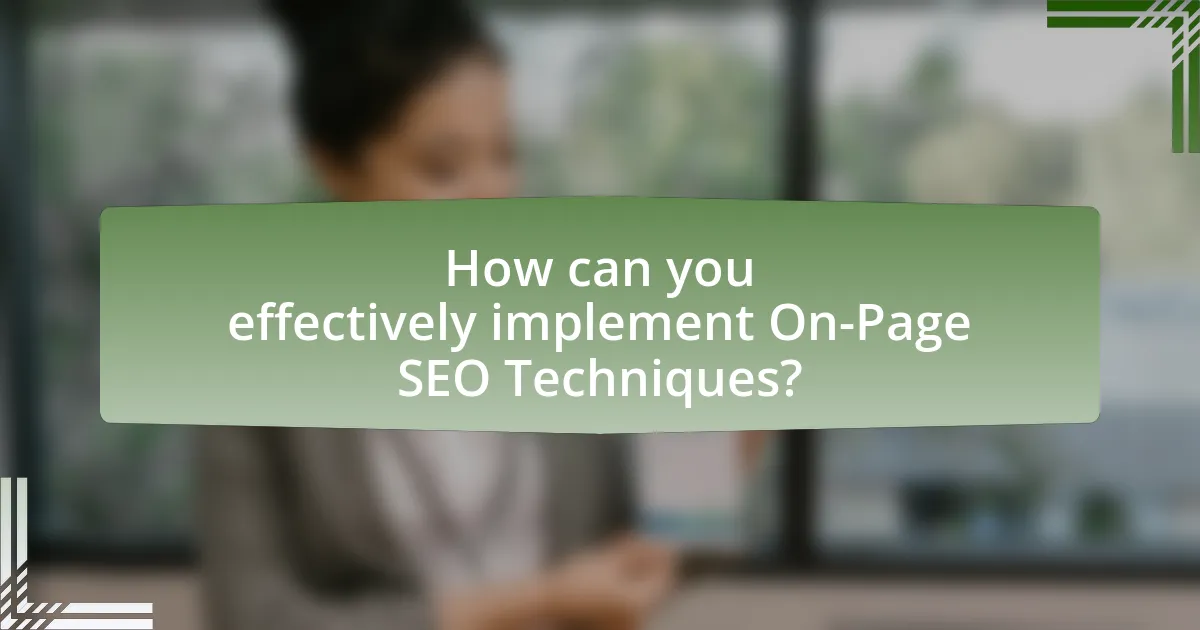
How can you effectively implement On-Page SEO Techniques?
To effectively implement On-Page SEO techniques, focus on optimizing key elements such as title tags, meta descriptions, headers, and content quality. Title tags should be concise, include primary keywords, and accurately reflect the page content, as they significantly influence search engine rankings. Meta descriptions must summarize the page content compellingly to improve click-through rates, while headers (H1, H2, H3) should structure content logically and incorporate relevant keywords to enhance readability and SEO. Additionally, high-quality, original content that addresses user intent and incorporates keywords naturally is crucial, as search engines prioritize valuable content. According to a study by Backlinko, pages with higher word counts tend to rank better, indicating the importance of comprehensive content. Furthermore, optimizing images with alt text and ensuring mobile-friendliness are essential for improving user experience and search visibility.
What are the best practices for optimizing title tags and meta descriptions?
The best practices for optimizing title tags and meta descriptions include using relevant keywords, maintaining appropriate length, and ensuring uniqueness for each page. Title tags should ideally be between 50-60 characters to avoid truncation in search results, while meta descriptions should be around 150-160 characters. Incorporating primary keywords at the beginning of both title tags and meta descriptions can enhance visibility and click-through rates. Additionally, crafting compelling and actionable language in meta descriptions can encourage user engagement. According to a study by Backlinko, pages with optimized title tags and meta descriptions can achieve higher rankings and increased organic traffic, demonstrating the importance of these elements in on-page SEO strategies.
How do title tags impact search engine rankings?
Title tags significantly impact search engine rankings by providing search engines with a concise summary of a webpage’s content. Search engines use title tags as a primary factor in determining the relevance of a page to a user’s search query. According to a study by Moz, title tags are one of the top on-page SEO factors influencing rankings, with a strong correlation between optimized title tags and higher search visibility. Properly crafted title tags that include relevant keywords can enhance click-through rates, further boosting rankings as user engagement signals are considered by search algorithms.
What are the characteristics of an effective meta description?
An effective meta description is concise, typically between 150-160 characters, and accurately summarizes the content of the webpage. It should include relevant keywords to improve search visibility and entice users to click through. Additionally, an effective meta description often features a clear call to action, encouraging user engagement. Research indicates that well-crafted meta descriptions can significantly increase click-through rates, with studies showing that pages with optimized descriptions can see up to a 5.8% increase in clicks compared to those without.
How should you structure your content for On-Page SEO?
To structure your content for On-Page SEO, use a clear hierarchy with headings, subheadings, and bullet points to enhance readability and organization. This structure allows search engines to better understand the content’s context and relevance. Implementing H1 for the main title, H2 for main sections, and H3 for subsections helps in creating a logical flow. Additionally, incorporating keywords naturally within these headings and throughout the content improves search visibility. Research indicates that well-structured content can lead to higher engagement rates, as users find it easier to navigate and comprehend, ultimately contributing to better SEO performance.
What is the importance of header tags in content structure?
Header tags are crucial for content structure as they organize information hierarchically, enhancing readability and user experience. By using header tags, such as H1, H2, and H3, content creators can clearly delineate sections and subsections, making it easier for readers to navigate the text. Additionally, search engines utilize header tags to understand the main topics and subtopics of a webpage, which can improve SEO rankings. Research indicates that pages with well-structured header tags can achieve higher visibility in search results, as they signal to search engines the relevance and context of the content.
How can internal linking enhance On-Page SEO?
Internal linking enhances On-Page SEO by improving site navigation, distributing page authority, and increasing the time users spend on a site. Effective internal links guide users to related content, which helps search engines understand the structure and relevance of the website. According to a study by Moz, internal links can significantly impact search engine rankings by helping to establish a hierarchy of information, allowing search engines to crawl and index pages more efficiently. Additionally, a well-structured internal linking strategy can reduce bounce rates and improve user engagement, further signaling to search engines that the content is valuable.
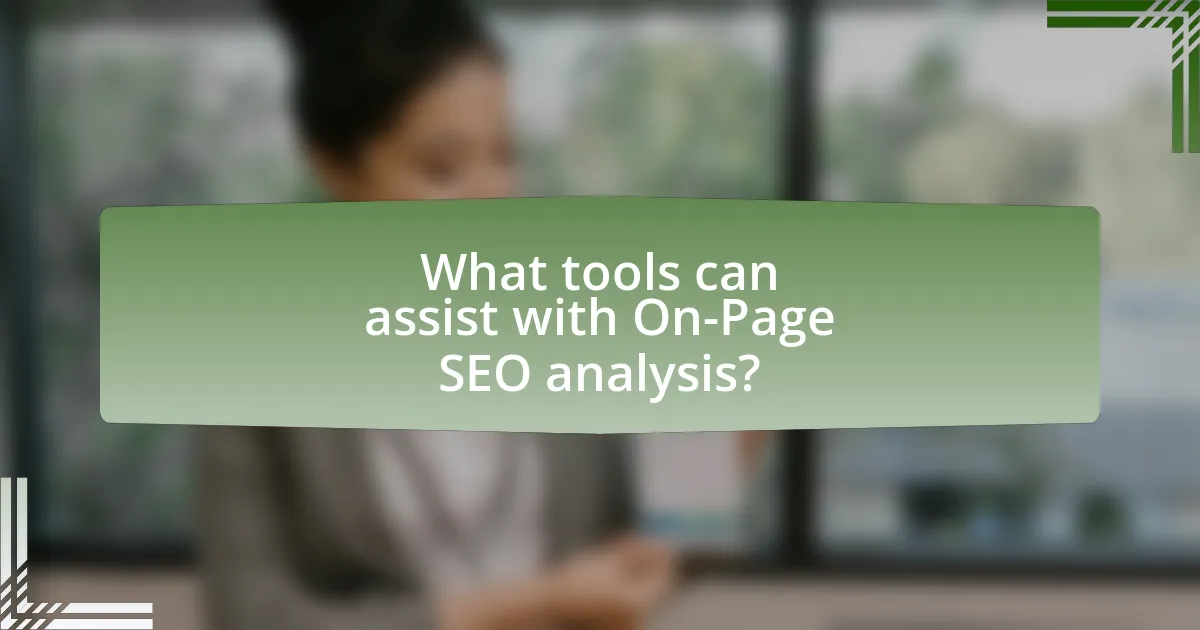
What tools can assist with On-Page SEO analysis?
Tools that can assist with On-Page SEO analysis include SEMrush, Ahrefs, Moz, and Screaming Frog SEO Spider. SEMrush provides comprehensive site audits and keyword analysis, while Ahrefs offers in-depth backlink analysis and content optimization suggestions. Moz features a user-friendly interface for tracking page optimization and keyword rankings. Screaming Frog SEO Spider allows users to crawl websites and identify technical SEO issues, such as broken links and duplicate content. These tools are widely recognized in the industry for their effectiveness in improving on-page SEO performance.
Which tools are most effective for keyword research?
The most effective tools for keyword research include Google Keyword Planner, SEMrush, Ahrefs, and Moz Keyword Explorer. Google Keyword Planner provides insights directly from Google, allowing users to discover keywords and their search volumes. SEMrush offers comprehensive keyword analysis, including competitive data and keyword difficulty scores. Ahrefs is known for its extensive database and ability to analyze keyword performance across various search engines. Moz Keyword Explorer provides keyword suggestions and SERP analysis, helping users understand the potential of each keyword. These tools are widely recognized in the SEO community for their accuracy and depth of data, making them essential for effective keyword research.
How can keyword research tools improve content strategy?
Keyword research tools enhance content strategy by identifying relevant keywords that align with user intent and search trends. These tools analyze search volume, competition, and related terms, enabling content creators to target specific topics that resonate with their audience. For instance, a study by Ahrefs found that 90.63% of web pages receive no organic traffic from Google, highlighting the importance of effective keyword targeting. By utilizing keyword research tools, marketers can optimize their content for higher visibility and engagement, ultimately driving more traffic and improving conversion rates.
What features should you look for in an SEO analysis tool?
An effective SEO analysis tool should include features such as keyword analysis, backlink tracking, site audit capabilities, and competitor analysis. Keyword analysis helps identify relevant search terms and their performance metrics, enabling users to optimize content effectively. Backlink tracking allows users to monitor the quality and quantity of inbound links, which are crucial for search engine rankings. Site audit capabilities provide insights into technical SEO issues, such as page speed and mobile-friendliness, which can impact user experience and rankings. Competitor analysis offers a comparative view of competitors’ strategies, helping users identify opportunities for improvement. These features are essential for comprehensive SEO analysis and optimization.
How can you measure the success of your On-Page SEO efforts?
You can measure the success of your On-Page SEO efforts by analyzing key performance indicators (KPIs) such as organic traffic, bounce rate, and keyword rankings. Organic traffic indicates the number of visitors arriving from search engines, reflecting the effectiveness of your on-page optimization. A decrease in bounce rate suggests that users find your content relevant and engaging, while improvements in keyword rankings demonstrate that your targeted keywords are performing well in search results. According to a study by Moz, websites that optimize their on-page elements can see a 50% increase in organic traffic within six months, validating the importance of these metrics in assessing SEO success.
What metrics should you track to evaluate On-Page SEO performance?
To evaluate On-Page SEO performance, track metrics such as organic traffic, bounce rate, average session duration, and keyword rankings. Organic traffic indicates the number of visitors arriving from search engines, reflecting the effectiveness of your SEO efforts. Bounce rate measures the percentage of visitors who leave after viewing only one page, with lower rates suggesting better engagement. Average session duration reveals how long users stay on your site, indicating content relevance and quality. Keyword rankings show the position of your targeted keywords in search engine results, which directly impacts visibility and traffic. These metrics collectively provide a comprehensive view of On-Page SEO effectiveness.
How can you use analytics to refine your On-Page SEO strategy?
You can use analytics to refine your On-Page SEO strategy by analyzing user behavior data to identify which pages perform well and which do not. By examining metrics such as bounce rate, average session duration, and conversion rates, you can pinpoint areas that require optimization. For instance, if a page has a high bounce rate, it may indicate that the content is not engaging or relevant to users, prompting a review and potential revision of the content or layout. Additionally, tools like Google Analytics provide insights into keyword performance, allowing you to adjust on-page elements such as title tags, meta descriptions, and headings to better align with user search intent. This data-driven approach ensures that your On-Page SEO efforts are targeted and effective, ultimately improving search engine rankings and user experience.
What are some common mistakes to avoid in On-Page SEO?
Common mistakes to avoid in On-Page SEO include neglecting title tags, failing to optimize meta descriptions, and overlooking header tags. Title tags should be unique and descriptive, as they significantly impact search engine rankings; a study by Moz indicates that optimized title tags can improve click-through rates by up to 20%. Meta descriptions must also be compelling and relevant, as they provide a summary of the page content and influence user engagement. Additionally, header tags (H1, H2, H3) should be used effectively to structure content, as proper use of headers enhances readability and helps search engines understand the content hierarchy. Ignoring keyword optimization, such as keyword stuffing or not using long-tail keywords, can also hinder SEO performance. Lastly, failing to ensure mobile-friendliness and fast loading times can negatively affect user experience and search rankings, as Google prioritizes mobile-optimized sites in its algorithm.
How can keyword stuffing negatively impact your SEO?
Keyword stuffing can negatively impact your SEO by leading to penalties from search engines, which can result in lower rankings or removal from search results. Search engines like Google prioritize user experience and relevance; when content is overloaded with keywords, it becomes less readable and less valuable to users. According to Google’s Webmaster Guidelines, excessive keyword usage is considered a manipulative practice that can harm a site’s credibility and visibility. This is supported by a study from Moz, which indicates that sites engaging in keyword stuffing often see a significant drop in organic traffic due to algorithm updates targeting such practices.
What are the consequences of neglecting mobile optimization?
Neglecting mobile optimization leads to significant consequences, including decreased user engagement and higher bounce rates. Research indicates that 53% of mobile users abandon sites that take longer than three seconds to load, which directly impacts traffic and conversion rates. Additionally, Google prioritizes mobile-friendly websites in its search rankings; thus, failure to optimize for mobile can result in lower visibility and reduced organic search traffic. This decline in user experience and search performance can ultimately harm a business’s revenue and brand reputation.
What practical tips can enhance your On-Page SEO in 2023?
To enhance your On-Page SEO in 2023, focus on optimizing content quality, improving page load speed, and ensuring mobile-friendliness. High-quality content that addresses user intent is crucial, as Google prioritizes relevant and valuable information, which can lead to higher rankings. Additionally, page load speed is a ranking factor; according to Google, a one-second delay in loading time can reduce conversions by 7%. Ensuring your website is mobile-friendly is essential, as mobile searches account for over 60% of all searches, making responsive design a necessity for better user experience and SEO performance.
